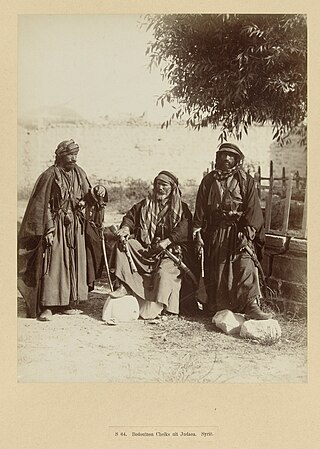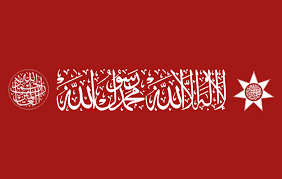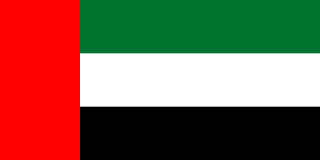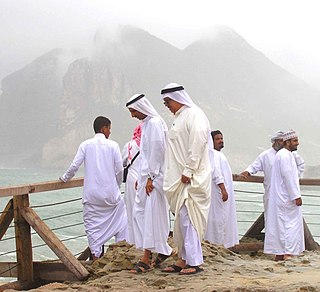Related Research Articles

The Arabs, also known as the Arab people, are an ethnic group mainly inhabiting the Arab world in West Asia and North Africa. A significant Arab diaspora is present in various parts of the world.

The Bedouin, Beduin, or Bedu are pastorally nomadic Arab tribes who have historically inhabited the desert regions in the Arabian Peninsula, North Africa, the Levant, and Mesopotamia (Iraq). The Bedouin originated in the Syrian Desert and Arabian Desert but spread across the rest of the Arab world in West Asia and North Africa after the spread of Islam. The English word bedouin comes from the Arabic badawī, which means "desert-dweller", and is traditionally contrasted with ḥāḍir, the term for sedentary people. Bedouin territory stretches from the vast deserts of North Africa to the rocky ones of the Middle East. They are sometimes traditionally divided into tribes, or clans, and historically share a common culture of herding camels, sheep and goats. The vast majority of Bedouins adhere to Islam, although there are some fewer numbers of Christian Bedouins present in the Fertile Crescent.

The Hejaz is a region that includes the majority of the west coast of Saudi Arabia, covering the cities of Mecca, Medina, Jeddah, Tabuk, Yanbu, Taif and Baljurashi. It is thus known as the "Western Province", and it is bordered in the west by the Red Sea, in the north by Jordan, in the east by the Najd, and in the south by the Region of 'Asir. Its largest city is Jeddah, which is the second-largest city in Saudi Arabia, with Mecca and Medina, respectively, being the fourth- and fifth-largest cities in the country.

Yasin al-Hashimi was an Iraqi military officer and politician who twice served as the prime minister. Like many of Iraq's early leaders, al-Hashimi served as a military officer during the Ottoman control of the country. He made his political debut under the government of his predecessor, Jafar al-Askari, and replaced him as prime minister shortly after, in August 1924. Al-Hashimi served for ten months before he was replaced, in turn by Abdul Muhsin al-Sa'dun. Over the next ten years he filled a variety of governmental positions finally returning to the office of prime minister in March 1935. On 30 October 1936, Hashimi became the first Iraqi prime minister to be deposed in a coup, which was led by General Bakr Sidqi and a coalition of ethnic minorities. Unlike al-Askari, who was then his minister of defense, al-Hashimi survived the coup and made his way to Beirut, Lebanon, where he died three months later. His older brother and close ally, Taha al-Hashimi, served as Prime Minister of Iraq in 1941.

The Banū Hāshim is an Arab clan within the Quraysh tribe to which Muhammad Ibn Abdullah belonged, named after Muhammad's great-grandfather Hashim ibn Abd Manaf.

The cultural setting of Saudi Arabia is greatly influenced by the Arab and Islamic culture. The society is in general deeply religious, conservative, traditional, and family-oriented. Many attitudes and traditions are centuries-old, derived from Arab civilization and Islamic heritage. However, its culture has also been affected by rapid change, as the country was transformed from an impoverished nomadic society into a rich commodity producer in just a few years in the 1970s. This change has also been affected by and the result of a number of factors including the communications revolution and external scholarships. The most recent ruler or king of Saudi is King Salman of Saudi Arabia.

Arabization or Arabicization is a sociological process of cultural change in which a non-Arab society becomes Arab, meaning it either directly adopts or becomes strongly influenced by the Arabic language, culture, literature, art, music, and ethnic identity as well as other socio-cultural factors. It is a specific form of cultural assimilation that often includes a language shift. The term applies not only to cultures, but also to individuals, as they acclimate to Arab culture and become "Arabized". Arabization took place after the Muslim conquest of the Middle East and North Africa, as well as during the more recent Arab nationalist policies toward non-Arab minorities in modern Arab states, such as Algeria, Iraq, Syria, Egypt, Bahrain, and Sudan.

Arab-Persians are people who are of mixed Arab and Persian descent. Historically, inter-ethnic marriages between Arabs and Persians have been common in Iran, Kuwait, Iraq, and Bahrain, as well as in Lebanon and Syria, albeit to a lesser extent.
The Bahārna are an ethnoreligious group of Shia Muslim Arabs indigenous to the historical region of Bahrain. They are generally regarded to be the original inhabitants of Eastern Arabia. They inhabited the area even before the arrival of the Banu Utbah in the 18th century which the Bahraini royal family descends from. Most Bahraini citizens are Baharna. Regions with most of the population are in Eastern Arabia, with significant populations in Kuwait, United Arab Emirates, Qatar, Oman, Iraq, and Hormozgan province of Iran.

The tribes of Arabia or Arab tribes denote ethnic Arab tribes originating in the Arabian Peninsula. These tribes trace their ancestry to one of the two Arab forefathers, Adnan or Qahtan.

Arab culture is the culture of the Arabs, from the Atlantic Ocean in the west to the Arabian Sea in the east, in a region of the Middle East and North Africa known as the Arab world. The various religions the Arabs have adopted throughout their history and the various empires and kingdoms that have ruled and took lead of the civilization have contributed to the ethnogenesis and formation of modern Arab culture. Language, literature, gastronomy, art, architecture, music, spirituality, philosophy and mysticism are all part of the cultural heritage of the Arabs.
The culture of Bahrain is part of the historical region of Eastern Arabia. Thus, Bahrain's culture is similar to that of its Arab neighbours in the Arabian Gulf region. Bahrain is known for its cosmopolitanism, Bahraini citizens are very ethnically diverse. Though the state religion is Islam, the country is tolerant towards other religions: Catholic and Orthodox churches, Hindu temples as well as a (now-defunct) Jewish synagogue are present on the island.

The color green has a number of traditional associations in Islam. It holds profound traditional associations within Islam, embodying themes of paradise, purity, and prosperity. In the Quran, green is linked with paradisiacal imagery, symbolizing the serenity of paradise. Green was adopted by the Shi'ites, and remains particularly popular in Shi'ite iconography, but it is also widely used in by Sunni states, notably in the flag of Saudi Arabia and the flag of Pakistan. Green's subsequent incorporation into national flags highlights the enduring significance in Islamic iconography.

The Emiratis are the citizen population of the United Arab Emirates. Within the UAE itself, their number is approximately 1.15 million.

Peninsular Arabic are the varieties of Arabic spoken throughout the Arabian Peninsula. This includes the countries of Saudi Arabia, Yemen, Oman, United Arab Emirates, Kuwait, Bahrain, Qatar, Southern Iran, Southern Iraq and Jordan.

Saudis or Saudi Arabians are an ethnic group and nation native to the Kingdom of Saudi Arabia, who speak the Arabic language, a Central Semitic language, and share a common ancestry, history, and culture. They are mainly composed of Arabs and live in the five historical Regions: Najd, Hejaz, Asir, Tihamah and Al-Ahsa; the regions which the Kingdom of Saudi Arabia was founded on or what was formerly known as the Kingdom of Hejaz and Nejd in the Arabian Peninsula. Saudis speak one of the dialects of Peninsular Arabic, including the Hejazi, Najdi, Gulf and Southern Arabic dialects, as a mother tongue.

The keffiyeh or kufiyyeh or cheffiyeh, also known in Arabic as a ghutrah (غُترَة), shemagh, or ḥaṭṭah (حَطَّة), is a traditional headdress worn by men from parts of the Middle East. It is fashioned from a square scarf, and is usually made of cotton. The keffiyeh is commonly found in arid regions, as it provides protection from sunburn, dust, and sand. An agal is often used by Arabs to keep it in place.

Thawb or thobe, is an Arab garment worn by inhabitants of the Arabian Peninsula. It is also referred to as jubbah, dishdashah, and kandura in varieties of Arabic. The thawb is long-sleeved ankle-length traditional robe; it is mainly worn by men in the Arabian Peninsula, Jordan, Syria, Palestine, Lebanon, North Africa, and some countries in East and West Africa, with regional variations in name and style. Depending on local traditions, a thawb can be worn in formal or informal settings; in the Gulf states thobes are the main formal attire for men. It is also worn by Muslim men in the Indian subcontinent due to its modest appearance, and is believed to be a sunnah, and it is commonly referred to as jubbah. The term "thobe" is also used in some varieties of Arabic to refer to women's attire, such as in Palestine and Sudan.
Hashemites, Hashimites, or Hashimids, may refer to:
Al-Hashimi, also transliterated Al-Hashemi, Hashemi, Hashimi, or Hashmi is an Arabic and Persian surname. The definite article Al- usually distinguishes the Arabic from the more numerous form.
References
- ↑ IRFAD. "Iraqi culture and fashion". IRFAD. Retrieved 17 July 2015.
- ↑ Holes, Clive Holes (2001). Culture and traditions of the Arabian gulf. BRILL. ISBN 9004107630 . Retrieved 17 July 2015.
- ↑ Oxford Islamic Studies. "Banu Hashim". Archived from the original on September 24, 2015.
- ↑ Stillman, Yedida (2000). Arab Dress (1 ed.). Brill. pp. 150–153. ISBN 9789004113732 . Retrieved 17 July 2015.